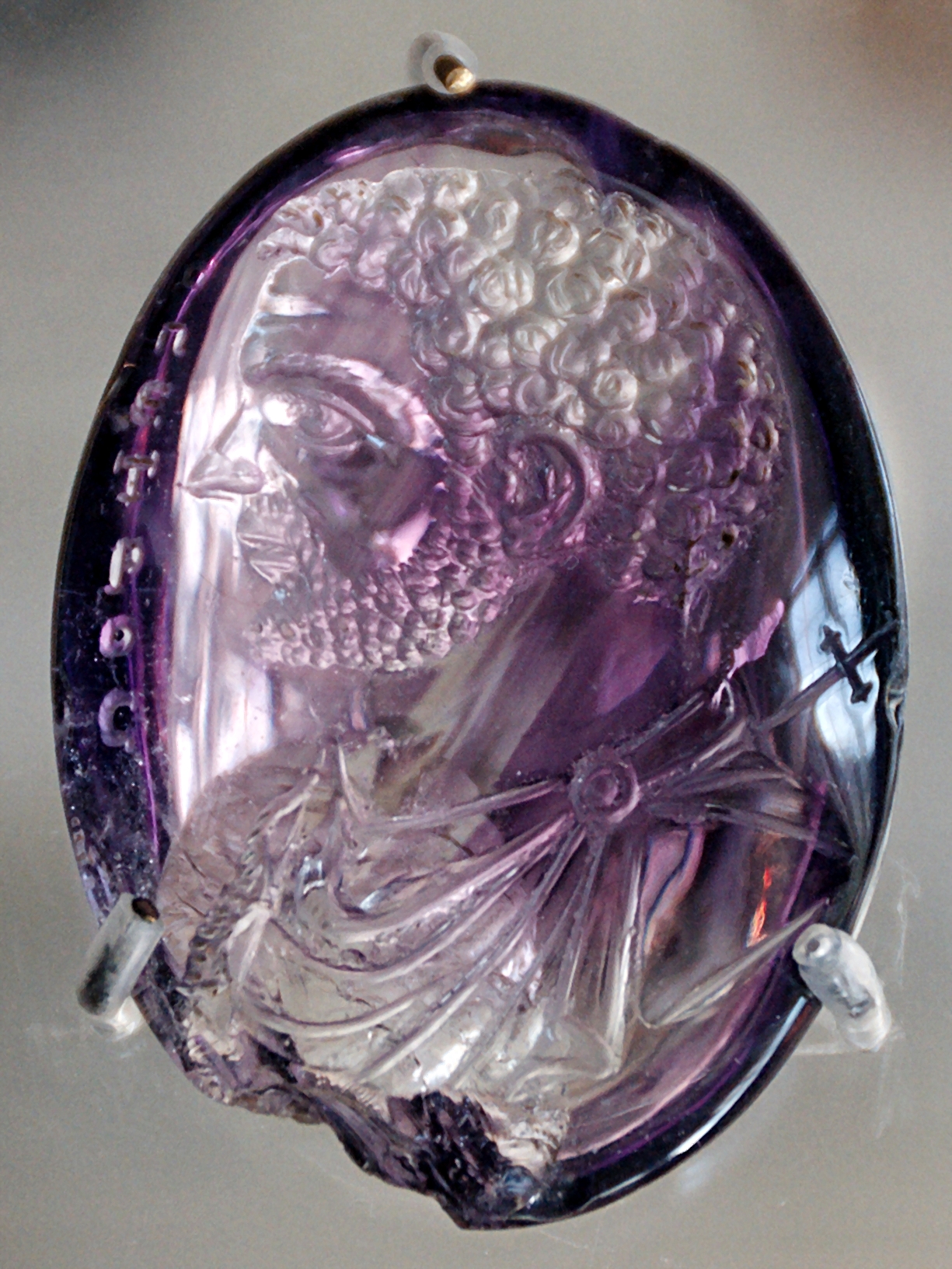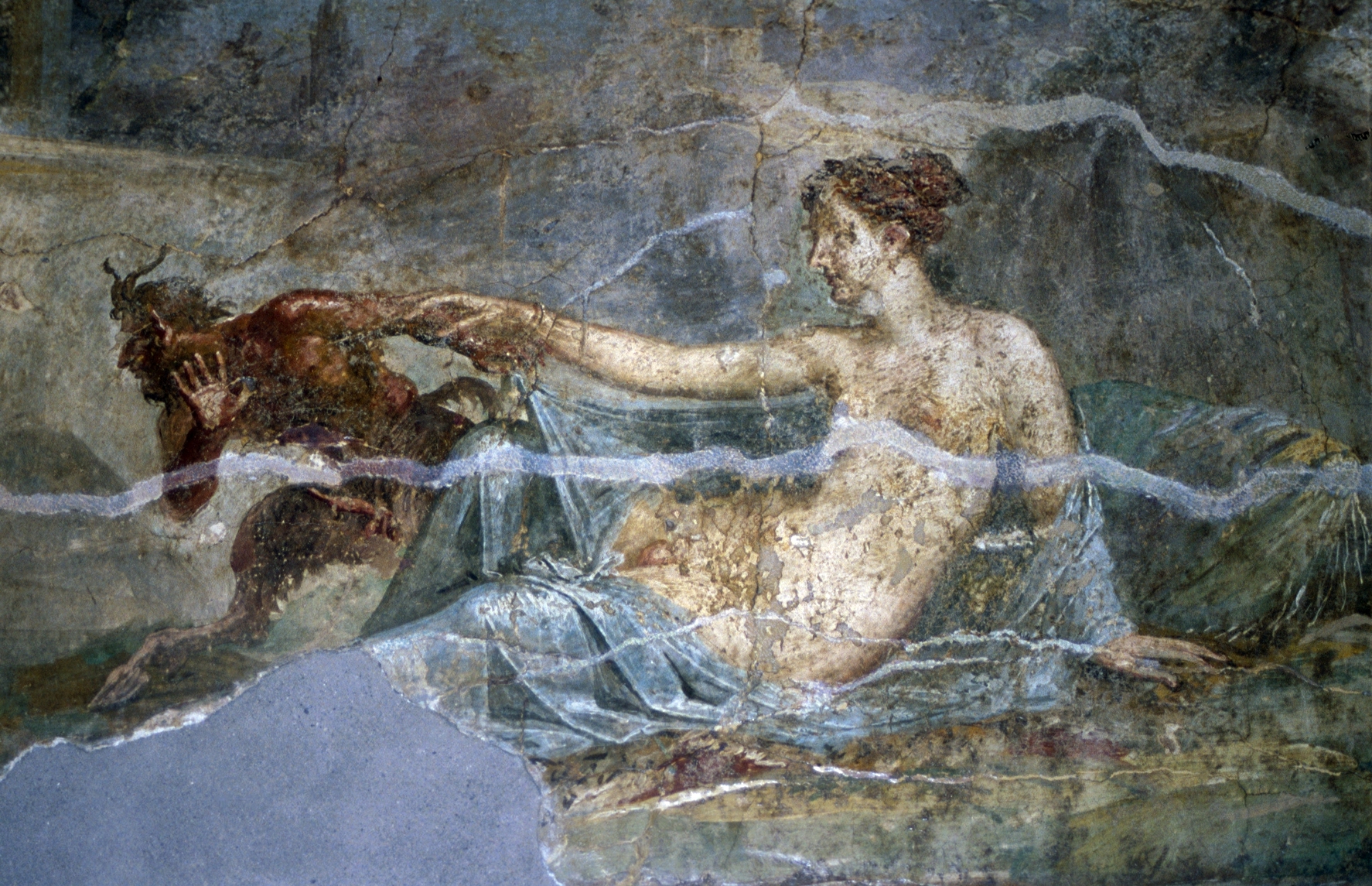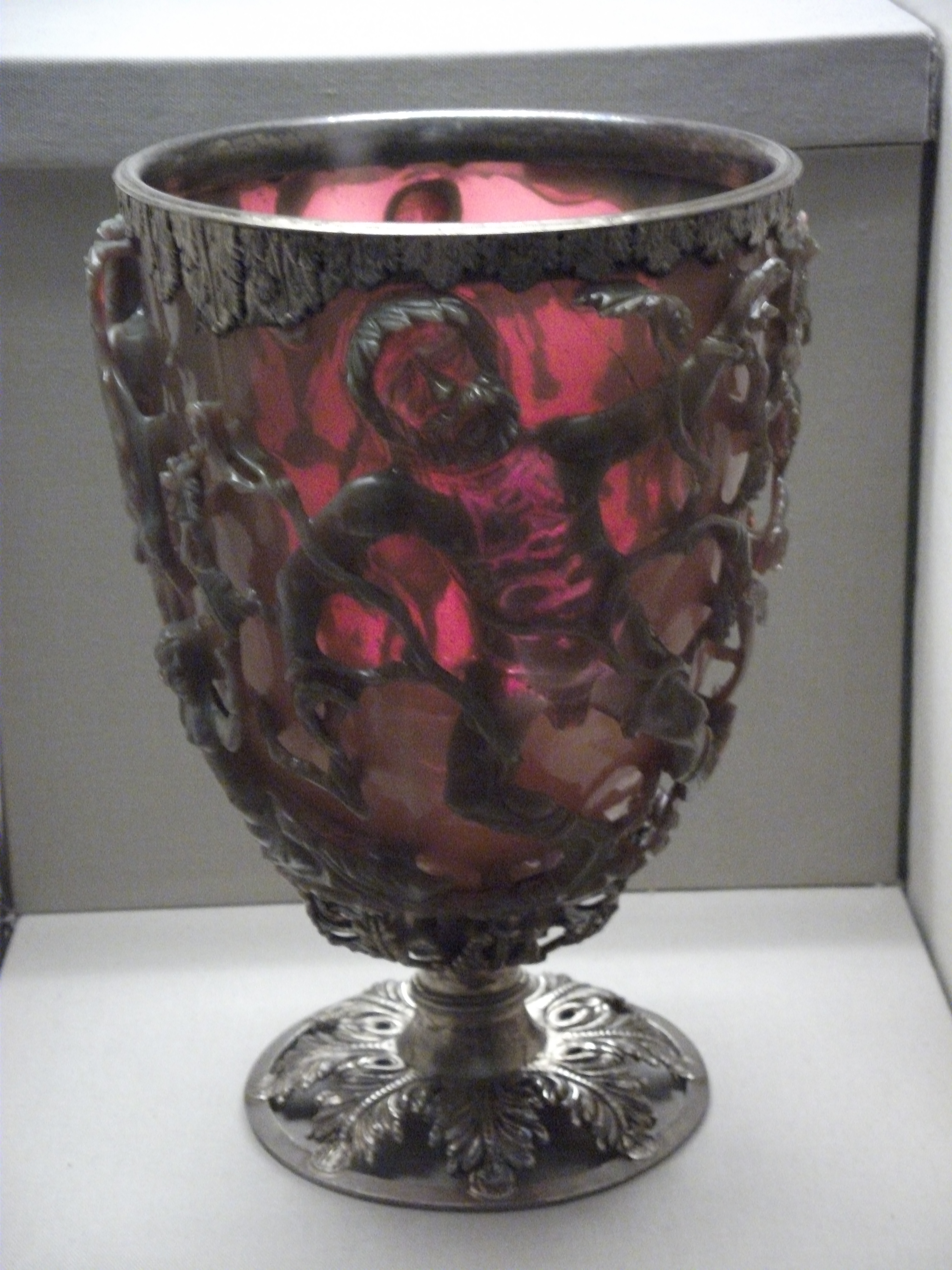|
Lycurgus Cup
The Lycurgus Cup is a 4th-century Roman glass cage cup made of a dichroic glass, which shows a different colour depending on whether or not light is passing through it: red when lit from behind and green when lit from in front. It is the only complete Roman glass object made from this type of glass, and the one exhibiting the most impressive change in colour; it has been described as "the most spectacular glass of the period, fittingly decorated, which we know to have existed". The cup is also a very rare example of a complete Roman cage-cup, or ''diatretum'', where the glass has been painstakingly cut and ground back to leave only a decorative "cage" at the original surface-level. Many parts of the cage have been completely undercut. Most cage-cups have a cage with a geometric abstract design, but here there is a composition with figures, showing the mythical King Lycurgus, who (depending on the version) tried to kill Ambrosia, a follower of the god Dionysus (Bacchus to t ... [...More Info...] [...Related Items...] OR: [Wikipedia] [Google] [Baidu] |
British Museum
The British Museum is a public museum dedicated to human history, art and culture located in the Bloomsbury area of London. Its permanent collection of eight million works is among the largest and most comprehensive in existence. It documents the story of human culture from its beginnings to the present.Among the national museums in London, sculpture and decorative and applied art are in the Victoria and Albert Museum; the British Museum houses earlier art, non-Western art, prints and drawings. The National Gallery holds the national collection of Western European art to about 1900, while art of the 20th century on is at Tate Modern. Tate Britain holds British Art from 1500 onwards. Books, manuscripts and many works on paper are in the British Library. There are significant overlaps between the coverage of the various collections. The British Museum was the first public national museum to cover all fields of knowledge. The museum was established in 1753, largely ... [...More Info...] [...Related Items...] OR: [Wikipedia] [Google] [Baidu] |
Engraved Gem
An engraved gem, frequently referred to as an intaglio, is a small and usually semi-precious gemstone that has been carved, in the Western tradition normally with images or inscriptions only on one face. The engraving of gemstones was a major luxury art form in the Ancient world, and an important one in some later periods. Strictly speaking, ''engraving'' means carving ''in intaglio'' (with the design cut ''into'' the flat background of the stone), but relief carvings (with the design projecting ''out of'' the background as in nearly all cameos) are also covered by the term. This article uses ''cameo'' in its strict sense, to denote a carving exploiting layers of differently coloured stone. The activity is also called ''gem carving'' and the artists ''gem-cutters''. References to antique gems and intaglios in a jewellery context will almost always mean carved gems; when referring to monumental sculpture, counter-relief, meaning the same as ''intaglio'', is more likely to be ... [...More Info...] [...Related Items...] OR: [Wikipedia] [Google] [Baidu] |
Thyrsus
A thyrsus /ˈθɜːrsəs/ or thyrsos /ˈθɜːrˌsɒs/ (Ancient Greek: θύρσος) was a wand or staff of giant fennel (''Ferula communis'') covered with ivy vines and leaves, sometimes wound with taeniae and topped with a pine cone, artichoke, or by a bunch of vine-leaves and grapes or ivy-leaves and berries, carried during Hellenic festivals and religious ceremonies. The thyrsus is typically associated with the Greek god Dionysus, and represents a symbol of prosperity, fertility, and hedonism similarly to Dionysus. Religious/Ceremonial use In Greek religion, the staff was carried by the votaries of Dionysus. Euripides wrote that honey dripped from the thyrsos staves that the Bacchic maenads carried. The thyrsus was a sacred instrument at religious rituals and fêtes. The fabulous history of Bacchus relates that he converted the thyrsi carried by himself and his followers into dangerous weapons, by concealing an iron point in the head of leaves. Hence his thyrsus ... [...More Info...] [...Related Items...] OR: [Wikipedia] [Google] [Baidu] |
Panthera
''Panthera'' is a genus within the family Felidae that was named and described by Lorenz Oken in 1816 who placed all the spotted cats in this group. Reginald Innes Pocock revised the classification of this genus in 1916 as comprising the tiger (''P. tigris''), lion (''P. leo''), jaguar (''P. onca''), and leopard (''P. pardus'') on the basis of common cranial features. Results of genetic analysis indicate that the snow leopard (formerly ''Uncia uncia'') also belongs to the genus ''Panthera'' (''P. uncia''), a classification that was accepted by IUCN Red List assessors in 2008. The tiger, lion, jaguar and leopard are the only cat species with anatomical structures that enable them to roar; the snow leopard cannot. The primary reason for this was formerly assumed to be the incomplete ossification of the hyoid bone. However, new studies show the ability to roar is due to other morphological features, especially of the larynx. Etymology The word ''panther'' derives from classical ... [...More Info...] [...Related Items...] OR: [Wikipedia] [Google] [Baidu] |
Pan (god)
In ancient Greek religion and mythology, Pan (; grc, Πάν, Pán) is the god of the wild, shepherds and flocks, rustic music and impromptus, and companion of the nymphs. He has the hindquarters, legs, and horns of a goat, in the same manner as a faun or satyr. With his homeland in rustic Arcadia, he is also recognized as the god of fields, groves, wooded glens, and often affiliated with sex; because of this, Pan is connected to fertility and the season of spring. In Roman religion and myth, Pan's counterpart was Faunus, a nature god who was the father of Bona Dea, sometimes identified as Fauna; he was also closely associated with Sylvanus, due to their similar relationships with woodlands. In the 18th and 19th centuries, Pan became a significant figure in the Romantic movement of western Europe and also in the 20th-century Neopagan movement. Origins Many modern scholars consider Pan to be derived from the reconstructed Proto-Indo-European god ''*Péh₂usōn'', wh ... [...More Info...] [...Related Items...] OR: [Wikipedia] [Google] [Baidu] |
Satyr
In Greek mythology, a satyr ( grc-gre, σάτυρος, sátyros, ), also known as a silenus or ''silenos'' ( grc-gre, σειληνός ), is a male nature spirit with ears and a tail resembling those of a horse, as well as a permanent, exaggerated erection. Early artistic representations sometimes include horse-like legs, but, by the sixth century BC, they were more often represented with human legs. Comically hideous, they have mane-like hair, bestial faces, and snub noses and are always shown naked. Satyrs were characterized by their ribaldry and were known as lovers of wine, music, dancing, and women. They were companions of the god Dionysus and were believed to inhabit remote locales, such as woodlands, mountains, and pastures. They often attempted to seduce or rape nymphs and mortal women alike, usually with little success. They are sometimes shown masturbating or engaging in bestiality. In classical Athens, satyrs made up the chorus in a genre of play known as a " ... [...More Info...] [...Related Items...] OR: [Wikipedia] [Google] [Baidu] |
Brit Mus Room 41 Lycurgus Cup No Lighting
Brit, Brits or BRIT may refer to: People Nicknames * British people, people of Great Britain and Northern Ireland, its Overseas Territories and the Crown Dependencies, and their descendants * Brit Hume (born 1943), American TV journalist * Brit Selby (born 1945), Canadian ice-hockey player * Brit Smith (born 1985), American actress, model, singer, and songwriter * Britney Spears (born 1981), American singer Given names * Brit Andresen, Norwegian-born Australian architect * Brit Bildøen (born 1962), Norwegian poet, novelist, essayist, children's writer and literary critic * Brit Hoel (born 1942), Norwegian politician * Brit Marling (born 1982), American writer, producer, director and actress * Brit McRoberts (born 1957), Canadian retired middle-distance runner * Brit Morgan (born 1987), American film and television actress * Brit Pettersen (born 1961), Norwegian former cross-country skier * Brit Sandaune (born 1972), Norwegian soccer player and pre-school teacher * Bri ... [...More Info...] [...Related Items...] OR: [Wikipedia] [Google] [Baidu] |
Cranberry Glass
Cranberry glass or Gold Ruby glass is a red glass made by adding gold salts or colloidal gold to molten glass. Tin, in the form of stannous chloride, is sometimes added in tiny amounts as a reducing agent. The glass is used primarily in expensive decorations. Production Cranberry glass is made in craft production rather than in large quantities, due to the high cost of the gold. The gold chloride is made by dissolving gold in a solution of nitric acid and hydrochloric acid ( aqua regia). The glass is typically hand blown or molded. The finished, hardened glass is a type of colloid, a solid phase (gold) dispersed inside another solid phase (glass). History The origins of cranberry glass making are unknown, but many historians believe a form of this glass was first made in the late Roman Empire. This is evidenced by the British Museum's collection Lycurgus Cup, a 4th-century Roman glass cage cup made of a dichroic glass, which shows a different colour depending on w ... [...More Info...] [...Related Items...] OR: [Wikipedia] [Google] [Baidu] |
Glass Blank
A glass blank is a piece of glass that requires additional decoration before it is considered finished. Types of decoration include cutting, engraving, acid-etching, gilding, and enameling. Often the term blank is used in reference to an uncut piece of glass that will be cut or engraved. "Blank" is used in the same way of pottery, especially porcelain, that was often decorated elsewhere, for example by hausmalers. Production The glassmaking process can be divided into several stages, including: melting ingredients to make raw glass, remelting raw glass to make objects (sometimes adding decorations while the glass is still hot), and adding decorations to cooled glass objects. The last stage is often where blanks are involved. These are pieces of glass made with the intention of adding decoration to the cooled piece. Blanks are sometimes made in the same factory or studio in which they are decorated, but blanks can also be made and sold by one company to another company that adds ... [...More Info...] [...Related Items...] OR: [Wikipedia] [Google] [Baidu] |
Corning Inc
Corning Incorporated is an American multinational technology company that specializes in specialty glass, ceramics, and related materials and technologies including advanced optics, primarily for industrial and scientific applications. The company was named Corning Glass Works until 1989. Corning divested its consumer product lines (including CorningWare and Visions Pyroceram-based cookware, Corelle Vitrelle tableware, and Pyrex glass bakeware) in 1998 by selling the Corning Consumer Products Company subsidiary (now known as Corelle Brands) to Borden. , Corning had five major business sectors: display technologies, environmental technologies, life sciences, optical communications, and specialty materials. Corning is involved in two joint ventures: Dow Corning and Pittsburgh Corning. Quest Diagnostics and Covance were spun off from Corning in 1996. Corning is one of the main suppliers to Apple Inc. Since working with Steve Jobs in 2007 to develop the iPhone; Corning ... [...More Info...] [...Related Items...] OR: [Wikipedia] [Google] [Baidu] |
Metropolitan Museum Of Art
The Metropolitan Museum of Art of New York City, colloquially "the Met", is the largest art museum in the Americas. Its permanent collection contains over two million works, divided among 17 curatorial departments. The main building at 1000 Fifth Avenue, along the Museum Mile on the eastern edge of Central Park on Manhattan's Upper East Side, is by area one of the world's largest art museums. The first portion of the approximately building was built in 1880. A much smaller second location, The Cloisters at Fort Tryon Park in Upper Manhattan, contains an extensive collection of art, architecture, and artifacts from medieval Europe. The Metropolitan Museum of Art was founded in 1870 with its mission to bring art and art education to the American people. The museum's permanent collection consists of works of art from classical antiquity and ancient Egypt, paintings, and sculptures from nearly all the European masters, and an extensive collection of America ... [...More Info...] [...Related Items...] OR: [Wikipedia] [Google] [Baidu] |
Palestine (region)
Palestine ( el, Παλαιστίνη, ; la, Palaestina; ar, فلسطين, , , ; he, פלשתינה, ) is a geographic region in Western Asia. It is usually considered to include Israel and the State of Palestine (i.e. West Bank and Gaza Strip), though some definitions also include part of northwestern Jordan. The first written records to attest the name of the region were those of the Twentieth dynasty of Egypt, which used the term "Peleset" in reference to the neighboring people or land. In the 8th century, Assyrian inscriptions refer to the region of "Palashtu" or "Pilistu". In the Hellenistic period, these names were carried over into Greek, appearing in the Histories of Herodotus in the more recognizable form of "Palaistine". The Roman Empire initially used other terms for the region, such as Judaea, but renamed the region Syria Palaestina after the Bar Kokhba revolt. During the Byzantine period, the region was split into the provinces of Palaestina Prima, Pal ... [...More Info...] [...Related Items...] OR: [Wikipedia] [Google] [Baidu] |




_(cropped).jpg)

.jpg)



